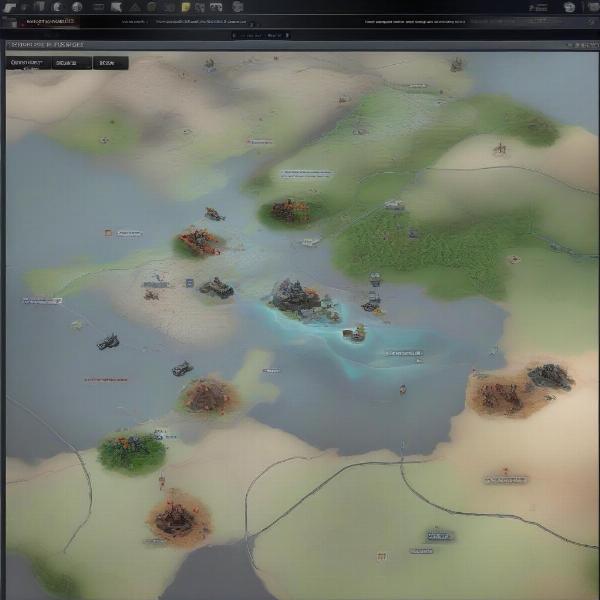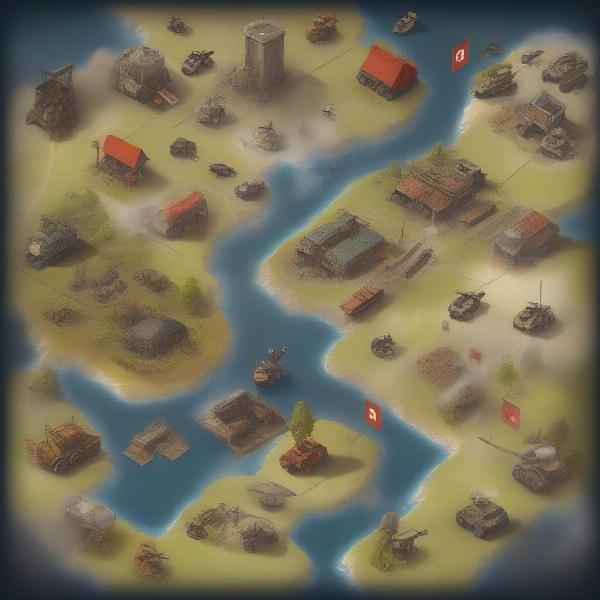The fog of war, a mechanic present in countless games, isn’t just about hiding information; it’s a fundamental tool that shapes player strategy and dictates the flow of gameplay. Here at supremeduelist.blog, we delve deep into the mechanics and strategies that define gaming, and today we explore how the fog of war influences everything from tactical decisions to overall game mastery. This element forces players to rely on scouting, planning, and adapting, transforming games from simple visual exercises into tests of strategic thinking.
The “fog of war,” a term borrowed from military contexts, translates to an area of the game map that is obscured from the player’s view. This mechanic adds an extra layer of complexity, forcing players to explore, gather intelligence, and anticipate enemy movements. By controlling what the player can see, developers create tension, heighten the risk, and add depth to the gameplay. This article will cover the different implementations of the fog of war, its impact on game design and player strategies, and offer tips on how to best navigate these obscuring elements in your favorite games. Understanding its mechanics is crucial for any player who wants to master their game of choice.
What is the Fog of War in Games?
The fog of war, often a grey or black veil that hides parts of the game world, fundamentally changes how players interact with the environment. It’s not just a visual trick; it is a dynamic element that influences decision-making, increases tension, and rewards strategic thinking. Games from Real-Time Strategy (RTS) and MOBAs to many single player RPGs often employ this feature.
In essence, the fog of war creates a sense of the unknown. Players are not fully aware of enemy positions, resource locations, or even the layout of the map until they have explored the area. This need for exploration and reconnaissance makes every decision more impactful. For instance, knowing when to take a risk to explore and when to hunker down becomes crucial. The fog of war is a mechanic that pushes players to be proactive in their intelligence gathering. This exploration mechanic mirrors many aspects of [macarthur’s strategy korean war game], where scouting and understanding the terrain is vital to success.
 Fog of war in an RTS game
Fog of war in an RTS game
How Does the Fog of War Work?
The fog of war generally works in one of two ways:
- Static Fog: The fog of war is only removed by player units or structures and does not return. This means once an area is explored, it remains revealed for the entire match. This is more prevalent in certain classic RTS or strategy games.
- Dynamic Fog: The fog is actively maintained by line of sight and will return if there are no player units or structures to keep it revealed. This means that the player must actively maintain and defend positions to have constant visibility, and the information obtained is only temporary. This is very common in modern RTS and MOBAs.
Line of sight (LoS) is a critical component of dynamic fog of war. Units and structures have a range of vision, and only what falls within that range is visible. This means that movement and positioning are as important as exploration for long-term vision. Some games have mechanics that extend visibility range, allowing for more strategic scouting and information-gathering opportunities.
What is the Search Intent for “Fog of War in Games?”
The primary search intent for “Fog Of War In Games” is informational. Users are looking to understand what the mechanic is, how it works, and how it affects gameplay. They might also be looking for tips and strategies for dealing with the fog of war. They are not typically looking to purchase a specific game or software, but rather to deepen their knowledge about game design mechanics.
The Impact of Fog of War on Game Design
The presence of the fog of war has a profound impact on several key areas of game design.
Strategic Depth
The fog of war increases the strategic depth of a game significantly. Players cannot simply react to situations that are readily visible. Instead, they must anticipate, plan, and invest in reconnaissance. This strategic depth often revolves around managing visibility and controlling information. Players need to determine how to use scouts, how to place vision structures, and when to risk advancing into the unknown. The use of vision is similar to the complex decision making one might find in [is war a lottery game], where knowledge of the enemy is the first step to success.
Player Engagement and Tension
By concealing information, the fog of war generates a natural tension and heightened player engagement. Knowing that an unseen enemy could be lurking around the corner makes every move more calculated and careful. This feeling is essential for the pacing and player experience of many genres, forcing players to constantly adapt to new information. This unknown pushes players to be more involved in their environment.
Fostering Teamwork and Communication
In multiplayer games, the fog of war can also promote teamwork and communication. Coordinating scout parties, relaying enemy information, and establishing lines of sight across the map become crucial tasks. This encourages cooperative gameplay and makes team communication an essential element for success. The fog of war thus becomes a catalyst for strategic collaboration among teammates.
 Fog of war in a multiplayer game
Fog of war in a multiplayer game
Tactics and Strategies for Navigating the Fog of War
Knowing how the fog of war works is only half the battle. Successfully managing it requires specific strategies and tactics. Here are some tips for navigating the obscured parts of a game map:
Scouting and Reconnaissance
Effective scouting is paramount for dealing with the fog of war. This could involve sending out lone units to explore, using specialized scouting units, or even employing spells or abilities designed to grant temporary vision. A good scout unit will be fast, ideally expendable, and can quickly gather information before an enemy has time to react.
- Early scouting: The beginning of the game is a great time to understand the layout of the map.
- Regular sweeps: Establish vision of the most important places on the map.
- Use expendable units: Don’t use valuable forces for simple scouting.
Map Control and Vision
Controlling key locations on the map gives a great advantage. By strategically positioning structures or units that grant vision, you can maintain a constant stream of information and prevent surprises. Always prioritize these areas, as losing vision can lose control over the flow of battle.
- Place vision structures: Strategic vision is very important for both attack and defense.
- Establish chokepoints: These are great places for vision control.
- Anticipate enemy movements: Use your vision to try and anticipate where an enemy might be.
Adaptive Planning
The fog of war makes it impossible to create a completely rigid plan at the beginning of the game. It is important to be adaptable and able to change plans as new information becomes available. Being open to improvisation is a must to stay on top of the game.
- Prioritize information: Focus on the most impactful areas of vision.
- Don’t get locked in: Being open to new plans is key to success.
- Be responsive: Always be willing to make changes.
Utilizing Vision Enhancements
Many games feature abilities, items, or units that can enhance vision. Learn which of these are available to you and how to effectively employ them. This might mean increasing unit vision range, using items to reveal hidden units, or employing specific abilities that briefly remove the fog of war in an area. Always try to find a vision advantage to have a leg up on the enemy.
- Recognize game specific tools: Always learn what is available to you.
- Utilize vision items: Items that give you sight are usually very powerful.
- Always look for advantages: Vision enhancements are key for success.
Expert Quote
“The fog of war is not simply a visual mechanic; it’s a strategic canvas,” says Dr. Anya Sharma, a leading game design analyst. “Players need to think like intelligence officers, gathering information, analyzing threats, and anticipating enemy actions. The better you navigate the fog, the more dominant you’ll be in the game.”
Frequently Asked Questions about the Fog of War
Here are some frequently asked questions to help you better understand the “fog of war”:
Why is the Fog of War important in video games?
The fog of war is important because it adds strategic depth, increases tension, and encourages careful planning. It forces players to engage with the game world more deliberately. It forces players to actively scout and collect information, raising the value of knowledge in video games.
How does the fog of war impact different game genres?
The impact varies across genres. In RTS games, it’s about scouting and base location. In MOBAs, it affects lane awareness and ganking. In RPGs, it’s about the feeling of exploration and discovering new areas. Each genre can use the fog to make the game more interesting.
Can the fog of war be turned off in games?
Some games might offer options to turn off the fog of war in a custom game mode or via a cheat code. But in general, it’s intended to be a core part of the gameplay experience. Most games are balanced around this feature, removing the fog of war will make the game too easy.
What are some common mistakes players make when dealing with the fog of war?
Some common mistakes include neglecting scouting, relying on minimal vision, and not being adaptive to new information. Poor map control can also hurt a player.
How does the fog of war simulate real-world situations?
The fog of war concept is borrowed directly from military strategy. In real life combat situations, full information is rare. This mechanic simulates that uncertainty, requiring constant adaptation and good use of intelligence to navigate uncertain situations. Similar to the challenges faced in [star wars jedi survivor new game plus], where adapting to the unknown can be key to overcoming difficult situations, understanding the game environment and anticipating possible dangers becomes very important.
How does the fog of war affect the pace of a game?
It slows the pace of play because players must explore and gather information before launching aggressive attacks. The fog of war often prevents players from rushing forward without a proper plan of action. This slower pace is generally beneficial, forcing players to engage on a deeper strategic level.
Expert Quote
“Mastering the fog of war is more than just a technical skill; it’s about strategic vision,” adds Ben Carter, a game balance expert. “The best players aren’t just reacting to what they see; they are anticipating what they cannot see, leveraging information asymmetry to their advantage.”
Conclusion
The fog of war is not merely a game mechanic; it’s a tool that shapes player experience, enhances strategic depth, and adds an extra layer of challenge. Understanding how it works and how to navigate it is key to mastering any game that uses this system. By implementing the strategies outlined above, you’ll be able to utilize your knowledge to more effectively navigate the unknown areas of your favorite games. Here at supremeduelist.blog, we will continue to explore and break down various gaming concepts, making you the most knowledgeable and powerful player you can be. Dive deeper into our content for more detailed guides and analysis to improve your game!
Leave a Reply